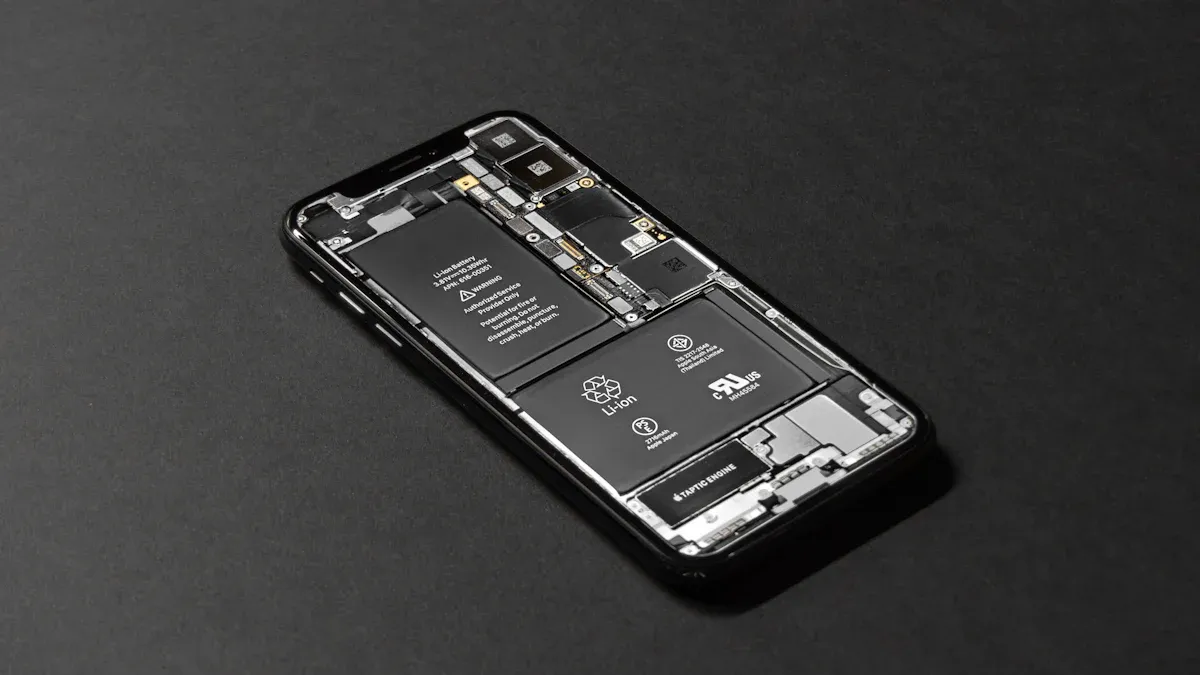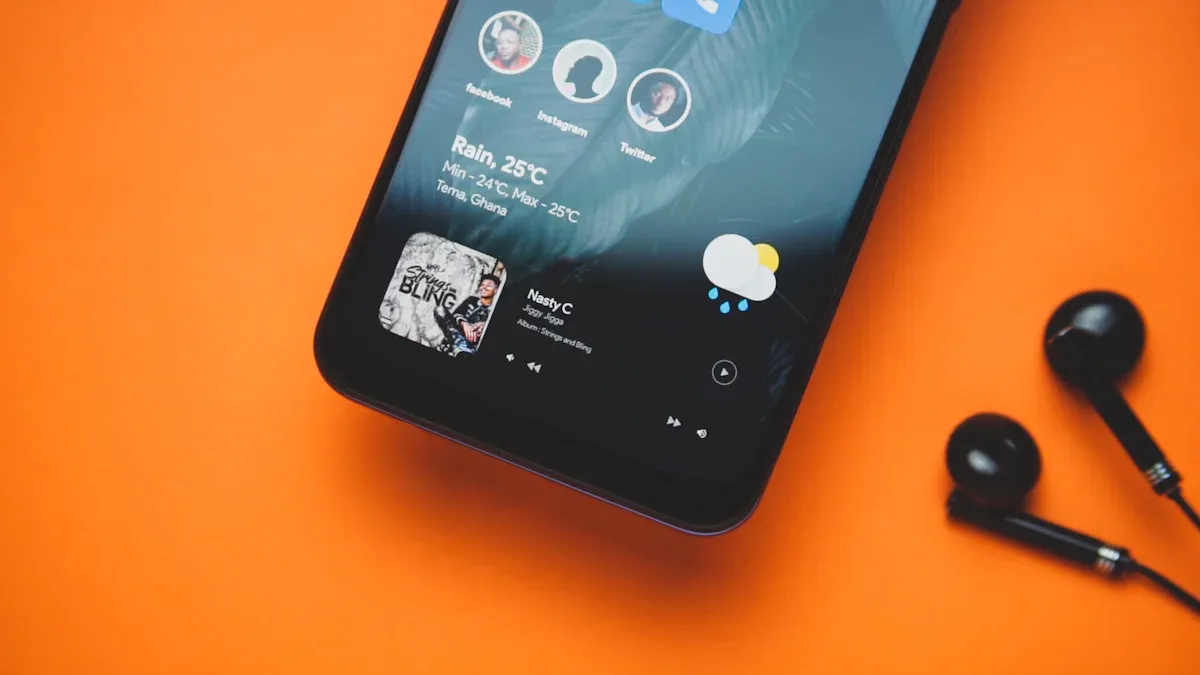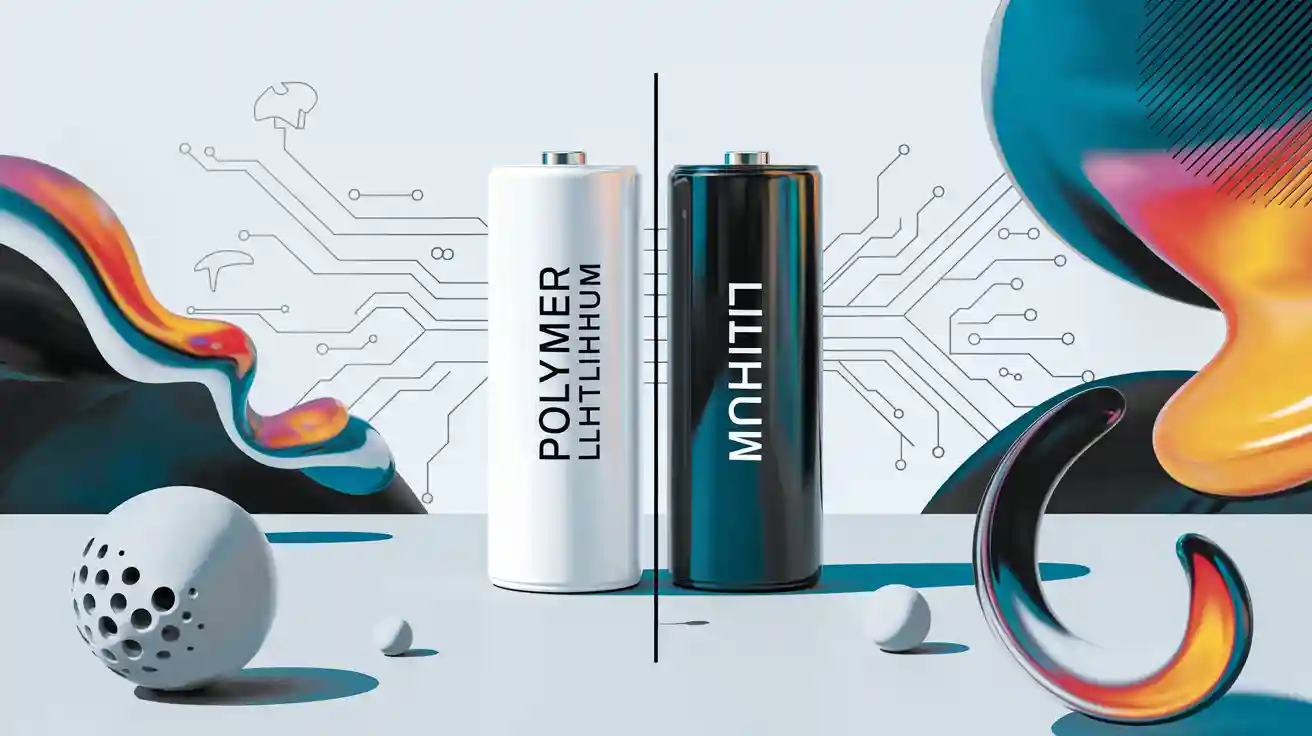The difference between Polymer lithium battery and lithium battery
You can see the main difference by looking inside each battery. Polymer lithium batteries have a solid or gel-like electrolyte. Lithium-ion batteries have a liquid electrolyte. This changes how each battery works in your devices. Polymer lithium batteries are light and flexible. They are also safer from leaks. You may want a polymer lithium battery for these reasons. Knowing these differences helps you choose the best battery. This is important for your phone, laptop, or car.
Key Takeaways
- Polymer lithium batteries have a solid or gel-like electrolyte. This makes them lighter and more bendable than lithium-ion batteries. Lithium-ion batteries use a liquid electrolyte.
- Pick polymer lithium batteries for slim and light devices. These are good for things like smartphones and wearables. They can fit into special shapes and help make thinner gadgets.
- Lithium-ion batteries hold more energy. This means they can run devices longer before charging. They work well for things like laptops and electric cars that need lots of power.
- Think about the price: polymer lithium batteries cost more to make. Lithium-ion batteries are cheaper and easier to find.
- Safety is important when picking a battery. Polymer lithium batteries are less likely to leak. Lithium-ion batteries can catch fire if they get damaged.
Polymer Lithium Battery
What Is a Polymer Lithium Battery
A polymer lithium battery has a special design. It uses a gel-like or solid polymer electrolyte, not a liquid. This makes the battery safe and flexible. The battery has several main parts. There is a positive electrode made from lithium-transition-metal-oxide. The negative electrode uses carbon material. A microporous separator keeps the parts apart. The polymer electrolyte helps the battery work. The table below lists the main parts and what they do:
| Component | Material Used | Function |
|---|---|---|
| Positive Electrode | Conductive polymer or inorganic compound | Site for lithium ion intercalation |
| Negative Electrode | Metal lithium or lithium carbon intercalation | Stores lithium ions during discharge |
| Electrolyte | Solid or colloidal polymer electrolyte | Conducts lithium ions and separates electrodes |
| Separator | Microporous polymer film | Prevents short circuits, allows ionic movement |
| Current Collectors | Copper (anode), Aluminum (cathode) | Conducts electrons to and from the electrodes |
Features and Benefits
Polymer lithium batteries have many good points. They are much lighter than other batteries. Their flexible pouch fits many device shapes. This helps make thinner and more comfortable gadgets. Phones, tablets, and wearables use these batteries. There is no hard metal case, so devices stay slim and light. The energy density can reach 300-400 Wh/kg. This means you get more power in a small battery. You also get longer battery life at lower voltages. Your device lasts longer between charges. The design lets companies make creative and small products. That is why polymer lithium batteries are popular for portable electronics.
Tip: If you need a battery for a special shape or want something light, a polymer lithium battery is a good choice.
Drawbacks
There are some downsides to polymer lithium batteries. They cost more to make than other batteries. There is no standard size, so most are custom-made. This makes them more expensive. Sometimes, the energy density is lower than regular lithium-ion batteries. The battery life and charge cycles may be shorter. You might need to replace the battery more often. Charging is slower, and the cost per unit of energy is higher. These problems can limit where you use polymer lithium batteries.
| Drawback | Description |
|---|---|
| Higher manufacturing cost | More expensive due to custom sizes and materials |
| Lower energy density | Sometimes less than standard lithium-ion batteries |
| Shorter battery life | Fewer charge/discharge cycles |
| No standard size | Custom shapes increase production cost |
| Higher cost/energy ratio | More expensive for the amount of energy provided |
Lithium-Ion Battery
What Is a Lithium-Ion Battery
Lithium-ion batteries are in many devices today. They use a liquid electrolyte inside. This liquid helps lithium ions move between electrodes. The battery stores energy for your device. It releases energy when you use your device. The liquid electrolyte keeps voltage stable. It works well in hot or cold weather. Phones, laptops, and electric cars use lithium-ion batteries. These batteries are strong and dependable.
The liquid electrolyte has solvents, salts, and additives. Each part does something important:
- Solvents help ions move and control temperature range.
- Salts give ions for moving and help with safety.
- Additives make the battery stable and stop bad reactions.
Note: Organic electrolytes work in many temperatures but can catch fire. Solid-state electrolytes are safer but cost more and do not conduct as well.
Features and Benefits
Lithium-ion batteries have many good points. They last longer on one charge because of high energy density. You can use your phone or car for hours before charging. The battery uses advanced materials for a long life. You save money because you replace the battery less often. The small size fits portable devices. You can carry your gadgets easily because the batteries are light.
- Long battery life keeps your device working.
- Fewer replacements save you money.
- Small and light batteries fit modern electronics.
You do not need to prime lithium-ion batteries before using them. Taking care of them is easy. The table below shows how lithium-ion batteries compare to polymer lithium batteries:
| Battery Type | Priming Requirement | Maintenance Requirement |
|---|---|---|
| Lithium-ion | No priming needed | Minimal maintenance required |
| Lithium Polymer | No priming needed | Similar minimal maintenance needed |
Drawbacks
Lithium-ion batteries have some problems. The battery lasts for 500 to 1000 charge cycles. It loses power over time and needs replacing. Safety is a worry. Overcharging or damage can cause fires or explosions. The battery does not like very hot or cold weather. Extreme temperatures lower performance and life. Getting lithium and cobalt hurts the environment.
- Battery life is limited and loses power.
- Safety risks include fires from overheating or damage.
- Cost is higher than older batteries.
- Mining for materials harms nature.
You cannot shape lithium-ion batteries as easily as polymer ones. The hard case makes it harder to design new devices.
Polymer vs. Lithium-Ion

Electrolyte and Design
There are big differences in how these batteries are made. Lithium-polymer batteries have a gel or solid polymer inside. This lets them be shaped in many ways. You see them in thin phones and fitness bands. These batteries are good for light devices. Lithium-ion batteries have liquid inside. Their metal case keeps them stiff. Most lithium-ion batteries are round or rectangle.
Here is a table that shows how flexible each battery is:
| Battery Type | Design Flexibility Description |
|---|---|
| Lithium-polymer batteries | Flexible pouch design allows for various shapes and sizes. |
| Lithium-ion batteries | Rigid metal casing limits design flexibility. |
| Lithium-polymer batteries | Can be molded into different shapes for slim, lightweight devices. |
| Lithium-ion batteries | Typically has a cylindrical or prismatic shape. |
If your device needs a special shape, lithium-polymer batteries give you more choices.
Performance
Performance is another way these batteries are different. Lithium-ion batteries hold more energy. Some new ones reach over 700 Wh/kg. Your phone or laptop can last longer before charging. Lithium-polymer batteries have good energy, but not as much. They use less energy to make, which helps the planet.
- Lithium-ion batteries last longer and give more power.
- Lithium-polymer batteries are better for nature because they use less energy to make.
Lithium-polymer batteries are lighter than lithium-ion batteries. For the same size, they are 40% lighter than steel case lithium-ion batteries. They are 20% lighter than aluminum case lithium-ion batteries. This makes your devices easier to carry.
Safety
Safety is important when picking a battery. Lithium-polymer batteries use a solid or gel inside. This lowers the chance of leaks. They protect better against short circuits. Lithium-ion batteries use liquid inside. If the case breaks, the liquid can leak and start fires. You need to be careful with lithium-ion batteries.
Always follow the rules for charging and storing batteries. This keeps you and your devices safe.
Cost
Cost matters when you choose a battery. Lithium-polymer batteries cost more to make and buy. They need special materials and are harder to build. For example, a 48V 100Ah lithium-polymer battery costs more than a similar lithium-ion battery. Fewer are made, so the price goes up. Lithium-ion batteries are cheaper because companies make lots of them.
If you want to save money and get good performance, lithium-ion batteries are best. If you want a slim, light battery and can pay more, lithium-polymer batteries may be better for you.
Applications

Best Use for Polymer Lithium Battery
Lipo battery packs are in many new devices. They are light and bend easily. This makes them great for thin gadgets. You can find lipo battery technology in smartphones, tablets, and wearables. These devices need thin batteries that fit special shapes. Lipo battery cells can charge fast. This means you use your device longer and wait less. In electric vehicles, lipo battery packs can be made in custom shapes. This helps car makers save space and balance the car’s weight.
Common uses for lipo battery:
- Smartphones
- Tablets
- Wearable devices
- Electric vehicles with custom battery layouts
Tip: Pick a lipo battery if you want a thin, light battery or need a special shape.
Best Use for Lithium-Ion Battery
Lithium-ion batteries are in many portable electronics and big energy storage systems. Li-ion battery packs power mobile phones, laptops, and tablets. These batteries hold a lot of energy, so your device works longer before charging. Li-ion battery cells are also used in e-bikes, scooters, and medical devices. In renewable energy, lithium-ion batteries store power from solar and wind. They give backup power to homes and help keep the grid steady.
| Industry/Device | Benefits of Lithium-Ion Batteries |
|---|---|
| Electric Vehicles (EVs) | High energy density, lightweight, long driving ranges, fast charging times. |
| E-Bikes and Scooters | Lightweight, quick recharge, eco-friendly transportation solution. |
| Renewable Energy Storage | Efficient energy storage for solar and wind, reliable backup power for homes and grid stabilization. |
| Medical Devices | Reliable power for portable defibrillators, hearing aids, and implantable devices. |
| Aerospace and Defense | High power in lightweight form for drones, military equipment, and satellites. |
| Power Tools and Equipment | Rechargeable, lightweight, and powerful for cordless tools and garden equipment. |
Note: Lithium-ion batteries are best for devices that need lots of power and long life.
Choosing the Right Battery
Think about what your device needs before you pick a battery. Lipo battery packs are flexible and light. Lithium-ion batteries have more energy and last longer. You should check these things:
- Capacity
- Voltage
- Size and weight
- Cycle life
- Discharge rate
- Operating temperature range
- Safety and reliability
- Cost
| Feature | Lithium-Polymer Batteries | Lithium-Ion Batteries |
|---|---|---|
| Weight | Lightweight, ideal for portable devices | Heavier, but higher energy density |
| Flexibility | Can be made in various shapes and sizes | Generally rigid, limited shapes |
| Energy Density | Lower energy density, suitable for slim devices | Higher energy density, better for power-hungry devices |
| Safety | Less likely to leak, reducing fire risk | More prone to leakage if damaged |
| Lifespan | Lower self-discharge rate, holds charge longer | Longer lifespan overall |
If you want a battery for a slim, light device, pick a lipo battery. If you need more power and longer life, choose a li-ion battery.
You can ask battery experts for help. They can help you pick based on your device’s weight, shape, and energy needs. Picking the right battery helps your device work well and last longer.
You can spot some big differences between polymer lithium batteries and lithium-ion batteries. Polymer lithium batteries have solid or gel electrolytes. They can be made in many shapes. They are safer when it gets hot. Lithium-ion batteries use liquid electrolytes. They hold more energy. They usually cost less.
When picking a battery, think about what your device needs. Safety, power, and price matter. Polymer lithium batteries are good for thin and light gadgets. Lithium-ion batteries are better for things that need lots of power and last longer. Always check safety and how fast the battery charges before you choose.
| Feature | Polymer Lithium Battery | Lithium-Ion Battery |
|---|---|---|
| Safety | Swells, less likely to explode | Can explode under stress |
| Energy Density | 300–400 Wh/kg | 150–250 Wh/kg |
| Cost | Higher | Lower |
-

 May.2025.11.24Ternary Lithium Battery vs Lithium-ion: Complete Comparison Guide (2025 Edition)Learn More
May.2025.11.24Ternary Lithium Battery vs Lithium-ion: Complete Comparison Guide (2025 Edition)Learn More -

 May.2025.11.214S2P 18650 14.8V Battery: Complete Technical Guide, Specs, Applications & SafetyLearn More
May.2025.11.214S2P 18650 14.8V Battery: Complete Technical Guide, Specs, Applications & SafetyLearn More -

 May.2025.11.18PCM vs BMS in Lithium Batteries: What’s the Difference and Which One Do You Need?Learn More
May.2025.11.18PCM vs BMS in Lithium Batteries: What’s the Difference and Which One Do You Need?Learn More -

 May.2025.11.17Custom Li-ion Battery Design for Medical Devices (2025 Comprehensive Guide)Learn More
May.2025.11.17Custom Li-ion Battery Design for Medical Devices (2025 Comprehensive Guide)Learn More -

 May.2025.11.17The Future of Lithium-Ion Batteries: Innovation, Sustainability, and Global Market TrendsLearn More
May.2025.11.17The Future of Lithium-Ion Batteries: Innovation, Sustainability, and Global Market TrendsLearn More
















